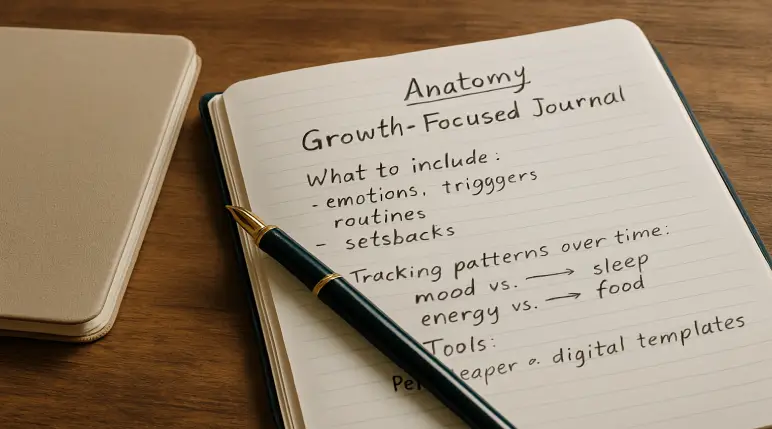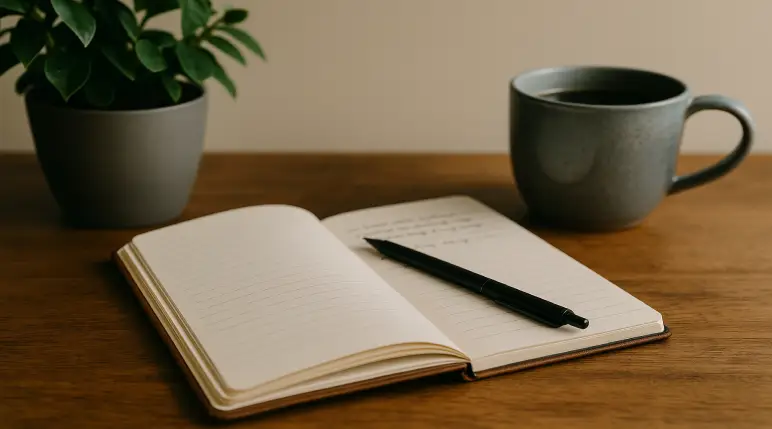In a world overflowing with productivity hacks, self-help podcasts, and motivational reels, one ancient practice is making a quiet but powerful comeback: journaling for personal growth. This isn’t about recording your every move or venting after a bad day. It’s about creating space to think, feel, and most importantly — notice. Notice who you’re becoming.
For many people in their 20s and 30s, life feels like a high-speed treadmill: chasing careers, navigating relationships, building identities. Amid this chaos, journaling has become more than just a notebook habit — it’s a tool for self-awareness. A way to pause, reflect, and ask, “What’s actually going on with me?”
But here’s the catch: writing events is easy. “I went to the gym,” “I had a fight,” “I missed a deadline.” The real magic happens when you track patterns — emotional rhythms, thought loops, habitual behaviors. You start to see what repeats. You realize your burnout isn’t random. Your anxiety has a schedule. Your motivation? It has a pattern too.
That’s when journaling for personal growth becomes transformative. It’s not about writing more. It’s about seeing deeper. And that’s exactly what this article is about: helping you turn your journal into a mirror — one that shows you not just what you did, but why you did it.
From Chaos to Clarity: Why Tracking Matters
Let’s be real — life often feels like a loop. Wake up, work, scroll, sleep. Repeat. And repeat again. Days blur into weeks, and suddenly, it’s August and you’re still wondering why your goals aren’t moving forward. But here’s the truth: life only feels repetitive until you track it.
That’s where the power of tracking habits with journaling comes in. Your brain is wired to forget patterns — especially the subtle ones. But when you write things down consistently, those hidden cycles start to surface. You stop guessing and start seeing.
Maybe you think you’re unproductive. But your journal shows a different story: you always struggle with focus after late-night Netflix binges.
Maybe you label yourself as “lazy.” But when you review your entries, a clear rhythm appears: every Thursday, your energy crashes. Why? Because Wednesday nights are packed with meetings, and you’ve been skipping dinner.
Tracking habits with journaling pulls you out of emotional storytelling (“I’m failing”) and into observable reality (“I’m drained by midweek”).
It’s not about judging yourself — it’s about understanding your patterns with compassion.
This shift from chaos to clarity doesn’t require fancy planners or rigid systems. Just a willingness to be honest, stay curious, and let your journal show you the loops you’ve been stuck in — and how to break free from them.
Ready to turn your reflections into lasting growth? Start tracking your patterns and habits today with the VerboAI app — the smart way to capture your thoughts, monitor your progress, and keep your personal growth journey alive. Download it now and make your memories work for your future self.

The Anatomy of a Growth-Focused Journal
Not all journals are created equal. If you’re using your notebook as a glorified to-do list or a dumping ground for bad moods, you’re only scratching the surface. A growth-focused journal is intentional. It’s designed not just to capture what happened, but to help you understand why it happened — and how to shift it.
So, what should go into it?
Think of your journal as a personal lab. You’re not just writing — you’re collecting data about yourself. Here are the core ingredients:
-
Emotions – What did you feel today? What triggered it? Don’t just name the feeling — explore it.
-
Triggers – People, places, thoughts, or behaviors that sparked a strong reaction.
-
Routines – What habits did you follow today? Morning rituals? Workflows? Sleep time?
-
Wins – Big or small. From crushing a presentation to simply drinking more water.
-
Setbacks – Missed habits, poor decisions, or energy dips — without judgment.
Over time, these entries become a goldmine for tracking patterns with journaling. You start noticing how your mood fluctuates based on your sleep quality. Or how your energy spikes on days when you eat breakfast and crashes on days you skip it.
You don’t need to analyze it every day — the insights come with reflection over time. And that’s where journaling for personal growth really shines: you stop reacting to life and start responding with awareness.
Paper or Digital? Choose Your Weapon.
There’s no “right” way to journal — only the way that works for you.
-
Pen & Paper – Great for slowing down, processing thoughts deeply, and disconnecting from screens. Many find it more personal and cathartic.
-
Digital Templates & Apps – Ideal for fast tracking, easy reviewing, and using tags or search functions. Bonus: many apps now include mood tracking, graphs, and habit logs.
The tool doesn’t matter as much as the habit. Choose the format that you’ll stick with — not the one that looks good on Instagram.
In the end, a growth-focused journal is less about the medium and more about the mindset: Curious. Honest. Consistent. That’s how you build a self-awareness muscle strong enough to support real change.

Breaking Bad Loops, Building Better Ones
We all have loops. Some help us thrive — like waking up early and moving our body. Others quietly hold us back — like doom-scrolling until midnight and skipping breakfast the next day. The worst part? Most of these patterns fly under the radar… until you start journaling.
One of the most underrated powers of journaling for personal growth is its ability to spot recurring self-sabotage. That little voice that says, “Just one more episode”, or “Skip the gym, you’re too tired.” When you journal consistently, those moments stop feeling random — you begin to see the pattern behind the excuse.
Maybe you notice that every time you make progress on a goal, you self-sabotage the next day with procrastination. Or that your low-energy days always follow emotional conversations. This is where the real work begins.
Redesigning Habits — One Tiny Change at a Time
Once you’ve spotted the pattern, you don’t need a complete life overhaul. You need one small shift.
And that’s the beauty of tracking habits with journaling — it gives you clarity on where to intervene, gently.
Let’s say you notice your productivity dies after lunch. What if you experimented with a walk instead of scrolling? Or prepped a lighter meal to avoid the afternoon crash?
Your journal becomes a place for micro-experiments: small, doable changes that you can test and track.
No pressure. No perfection. Just slow, intentional redesign of your daily loops.
Reflect. Reinforce. Repeat.
Don’t underestimate the power of a weekly reflection. It’s your personal review meeting — no corporate jargon needed.
Ask yourself:
-
What worked this week?
-
What didn’t?
-
Where did I fall into old loops?
-
What’s one change I want to test next week?
When done regularly, these reflections reinforce awareness and progress. They help you stay connected to your goals, your energy, and your real needs — not just your to-do list.
Because journaling for personal growth isn’t about tracking to feel guilty. It’s about tracking to grow — with more grace, more intention, and fewer self-inflicted roadblocks.

Real Stories, Real Shifts
Sometimes, all it takes is a pen, a notebook, and the courage to look inward. Journaling for personal growth isn’t just about feeling better — it’s about understanding yourself better. And often, the smallest realizations lead to the biggest transformations.
📖 Case 1: Midnight Scrolls, Morning Anxiety
Amir, 27, constantly woke up with chest-tightening anxiety. He chalked it up to stress or work pressure. But after two weeks of tracking his habits with journaling, a pattern became clear: his worst mornings always followed nights spent doom-scrolling on social media in bed.
Once he saw the link in black and white, it clicked. He replaced his nighttime scrolling with reading 10 pages of a book. Within a month, his morning anxiety significantly dropped — not because of therapy or medication, but because of a single “aha” moment, made visible through journaling.
📖 Case 2: The Post-Lunch Crash
Sophia, 32, couldn’t understand why her productivity tanked every afternoon. Her journal entries revealed the truth: she was eating heavy carb-loaded lunches and skipping hydration.
She didn’t need to “work harder” — she needed to change what was fueling her. She adjusted her meals, added a walk after lunch, and soon, her afternoons went from foggy to focused.
Another micro-pattern, uncovered through consistent reflection.
📖 Case 3: The Social Battery Mystery
Jared, 30, felt like he was constantly letting his friends down. He’d agree to plans, then cancel last-minute, blaming exhaustion. But as he started journaling for personal growth, he realized he was booking social events back-to-back with high-stress workdays.
His journal showed him that he wasn’t flaky — he was simply overwhelmed. With that insight, he began planning recharge days between social outings, and suddenly, his relationships (and energy) improved.
These are not dramatic before-and-after stories. They’re subtle, human, and deeply personal.
They remind us that aha moments don’t come from hustle — they come from reflection. From having a space to observe, question, and learn from our own lives.
That’s what journaling does. It gives you evidence. It gives you clarity.
And sometimes, it gives you the permission to stop blaming yourself — and start supporting yourself instead.

Journaling Rituals That Stick
The biggest reason people stop journaling? They treat it like a chore. A box to check. Another “should” on an already overwhelming to-do list.
But the secret to long-term success is this: make it a ritual, not a task.
Rituals feel grounding. Comforting. Something you look forward to. And that’s exactly how your journaling practice should feel — not forced, but fluid. Not perfect, but personal.
✏️ Micro-Journaling for the Busy Mind
Think you’re too busy to journal? You’re not. You just haven’t found your way yet.
Enter: micro-journaling.
It’s journaling stripped down to the essentials — one to three lines a day. That’s it. Enough to notice patterns. Enough to stay connected. Without the pressure of writing paragraphs.
Here are a few prompts to keep it light but powerful:
-
What drained me today?
-
What energized me?
-
One habit I followed (or skipped) and why
Over time, these micro-entries add up to macro-insights.
🕰️ The Best Time to Journal for Pattern Recognition
Timing matters more than you think — not just for habit-building, but for awareness.
Some people prefer evening journaling to reflect on the day and capture emotions while they’re still fresh. Others find that morning journaling helps set intentions and track residual patterns from the day before (like energy, mood, or sleep).
So, what’s the “best” time?
👉 The time you’ll actually stick with.
But if your goal is to track habits and identify patterns, a good combo is:
-
Morning: to note energy, sleep quality, mood upon waking
-
Evening: to review actions, emotional triggers, and behaviors
Think of your journal as your mirror — and checking in with it twice a day is like adjusting your focus. You see more. You understand more. You become more.
In the end, journaling for personal growth isn’t about perfection or aesthetics. It’s about showing up for yourself, even if it’s just with a few honest words a day.
The ritual isn’t in the writing. It’s in the returning — to your thoughts, your patterns, your progress.

Conclusion
In this article, we explored how journaling for personal growth is more than just writing — it’s about seeing. Seeing the hidden patterns, the quiet self-sabotage, the overlooked wins, and the moments where change is already trying to happen.
By consistently tracking habits with journaling, you don’t just become more organized — you become more aware. You start to notice the loops that hold you back, the routines that empower you, and the emotions that need more space. Journaling becomes your mirror, your compass, and sometimes, your therapist.
It doesn’t require fancy tools or hours of free time. Just the courage to be honest — even if it’s only for a few minutes a day.
So whether you’re chasing personal growth, trying to redesign your habits, or simply longing for more clarity in the chaos of daily life, start with a pen. Or a note on your phone. Start small. But start.
Because the story you’re living is already meaningful.
Your journal just helps you understand it better — and write the next chapter with intention.


